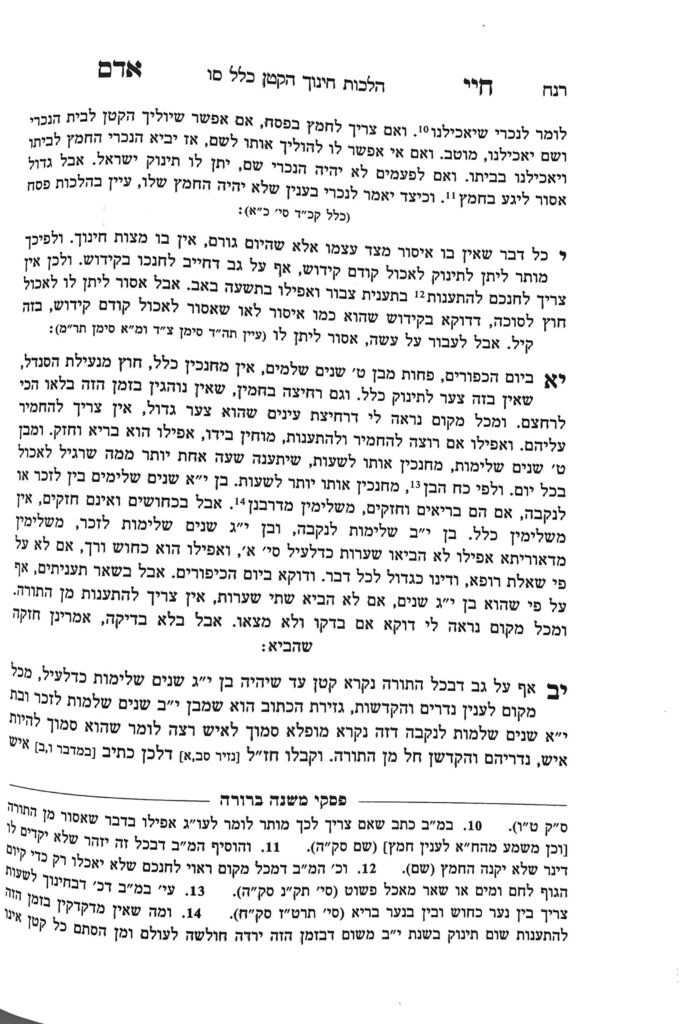We are beginning siman 10. The Chayei Adam writes that a food which is not intrinsically assur, but is assur because of an impediment due to the day, can be fed to a katan. For example, although there is an issur against eating before kiddush, since there is nothing inherently assur about food before kiddush is recited, one may feed a katan before kiddush. Similarly, one can feed a katan on a taanis.
Regarding a taanis, the Mishnah Berurah points out that a katan should be taught that a tragedy occured to Klal Yisroel on that day, and therefore should be given more basic foods, so that they can join in the taanis at their level.
The Chayei Adam asks that, if we understand that the chiyuv chinuch does not apply when the issue with the food is external, there should not be any issue with feeding a child outside of the sukkah, since the food is not intrinsically assur. However, we learned previously (shiur 1286) that the father cannot directly nor indirectly feed their child outside the sukkah. He explains that the difference between eating before kiddush (for example) and sukkah is that eating before kiddush is an issur. There is no chiyuv chinuch on a lo saasei when there is nothing intrinsically wrong with the item. However, the mitzvah of Sukkah is a positive mitzvah, and there is an obligation for the father to teach his child how to correctly perform mitzvos asei. If the father (or any person) were to feed his child outside the Sukkah, they would directly undermine and contradict the chiyuv chinuch to teach the child to eat in the sukkah, so it is assur.
A similar question comes up regarding requiring a child to wait between michligs and fleishigs. We know that the standard minhag in Klal Yisroel is six hours (although there are minhagim of one and three hours as well). In addition to a waiting period, we know that one must perform kinuach v’hadacha (cleaning out one’s mouth) before switching between milchigs and fleishigs.
Under the age of three, the assumption in halacha is that a child can eat milchigs immediately after fleishigs, provided that one ensures the child has performed kinuach v’hadacha. Since milchigs are necessary for the growth of the child, Chazal did not want them to be withheld from the child.
Between the ages of three to six, one should try to ensure their child waits one hour, which was originally the primary chiyuv.
Once the child has reached the age of six, assuming the child is healthy, one should try to ensure their child waits six hours. However, if a child refuses to wait or eat other foods, one may be meikil until age nine or ten.
If a child over six eats milchigs and fleishigs right after each other, they should recite a bracha achrona in between, because the original takanah from Chazal prohibited eating milchigs and fleishigs in the same meal.
Summary
- There is no chiyuv chinuch on a lo saasei when there is nothing intrinsically wrong with the item. Therefore, one may feed their child before kiddush or on a taanis.
- However, there is still a chiyuv chinuch on mitzvos asei. Therefore, one cannot allow their child to eat outside the sukkah.
- Others may not feed a child outside of the sukkah.
- Regarding children waiting between milchigs and fleishigs:
- Between 0-3: no waiting necessary; perform kinuach v’hadacha
- Between 3-6: wait one hour; perform kinuach v’hadacha
- Above 6: wait six hours
- If a child does not wait and wishes to eat the other type of food immediately, they should recite a bracha achrona between the types of food.



